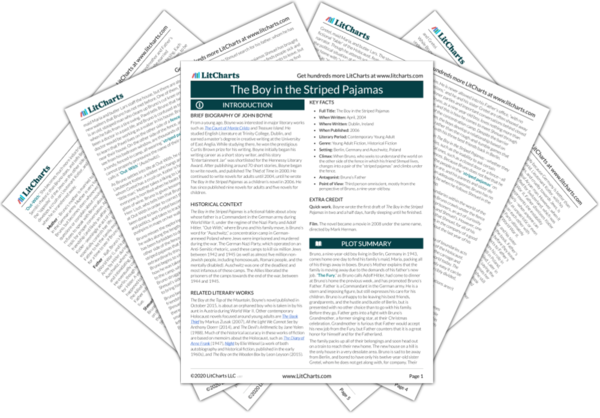Summary
Analysis
Outside the window, Gretel realizes that what Bruno has seen are not just children: they are men of all ages, everywhere. The two children have no idea what they are doing there, and are unsure where all the women are. They guess that perhaps the women live in “a different part.” Gretel is very surprised—her own window faces a forest, and she had not known that other people lived near them until now. Upon further inspection, she sees that the people live on the other side of a very high fence, with “huge wooden posts, like telegraph poles, dotted along it, holding it up.” The top of the fence has barbed wire. Beyond the fence there is no greenery, only some kind of sand-like substance, low huts, and large square buildings.
The children can tell that this is a very inhospitable environment for people to live in—but because they are both young and almost impossibly sheltered, they don’t fully understand the extent of wartime realities. Bruno and Gretel thus are forced (or force themselves) to believe that the people across the fence have chosen to live there. It is especially chilling to hear a death camp described through the eyes of a naïve child.
Themes
Gretel and Bruno are confused as to who would “build such a nasty-looking place.” Bruno guesses that they are living in the countryside now, which is why there are so few people and businesses around compared to their home in Berlin. Gretel wonders where the farms are, as she learned in school that the food they receive in the city comes from farmers in the countryside. She hopefully wonders if this is their “holiday home.” Bruno disagrees, and the two children decide that what they’re looking at definitely isn’t any kind of farm, and so this probably isn’t the countryside or some kind of holiday home.
As the children both grew up in a wealthy household in the busy city of Berlin, they have no idea what to make of this new desolate location. The only alternative to a city home that they can imagine is a “country home.” Due to their extremely sheltered lives and the filtered information they receive, they have absolutely no idea what kind of place Auschwitz truly is or could be.
Themes
The children continue to wonder who the people they see are. They can see people of all ages and sizes, in groups, marching around, and being shouted at by a soldier. Some are pushing wheelbarrows together, as if in a chain gang, and others have crutches and bandages around their heads. Some carry shovels, or are “being led by groups of soldiers to a place where they could no longer be seen.” Bruno and Gretel are both confused as to why their Father would move them from a nice street in Berlin to such a desolate place with so many people.
The children perceive everything only through their own narrow worldview, so they have no thought for the plight of the people they’re watching—only for themselves. They are bewildered by the fact that Father chose to move them from the happiness they had in Berlin to this horrible new location. The comparison of the people to a “chain gang” shows that the children should at least have some frame of reference for what prisoners look like, however.
Themes
The two children notice a group of other children on the other side of the fence, huddled together and being shouted at by a soldier. They move in closer together the more the soldiers shout, and when one soldier lunges at the group, they scatter, until the soldier tells them to get into a single line, and he laughs. Gretel wonders if it’s some kind of rehearsal, even though most of the children look like they’re crying. Gretel announces that she wouldn’t want to play with children like that, since they all look very dirty. Bruno wonders if maybe there are no baths on the other side of the fence, and Gretel tells him not to be stupid: what kind of people don’t have baths? Bruno guesses that people who don’t have hot water don’t have baths. Gretel shivers, and turns away from the window, having had enough of the sight. She goes into her room to arrange her dolls, where “the view is decidedly nicer.” But instead of arranging her dolls, she just sits on her bed and thinks about what she has seen. Bruno continues to stare out of the window, and he notices one thing he had not seen before: everyone, grandfathers and fathers and little boys, are all wearing “a pair of grey striped pajamas and a grey striped cap on their heads.”
Bruno and Gretel again seem younger than Boyne portrays them as, as they seemingly can’t even comprehend a life without a family, sufficient food, or a bath in which to wash. They attempt to project their youthful positivity onto what they see in the camp, but they both know that there is something uneasy and sinister about the situation. As competitive siblings, they each do their best to mask their uneasiness about the camp when speaking to each other. This shows another aspect of the phenomenon of complicity—people reassure each other and unconsciously help each other to remain complacent or purposefully ignorant in the face of injustice. Gretel does this more obviously than Bruno (perhaps because she is older), purposefully choosing to avoid looking at the depressing prisoners and instead choosing to return to her sheltered, idyllic world of dolls and innocence.
Themes
Get the entire Striped Pajamas LitChart as a printable PDF.













